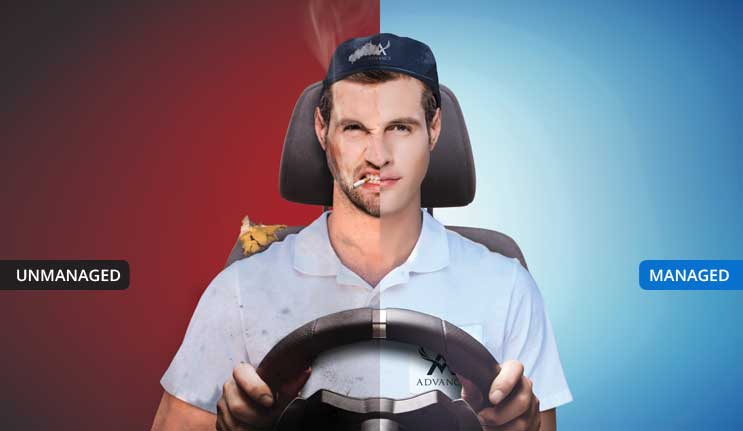I think as a whole, we always try our best. Most people enjoy positive feedback for a job well done. And like most people, we tend to frown upon negative feedback we’re given for a job poorly done. When we get right down to it, most of the time we do a poor job, it was fully our own doing. We either did not think things through or it was based on a negative attitude. This is very true, especially when it comes to our driving attitude.
When it comes to driving etiquette, driving a commercial vehicle professionally could be considered more important than driving a regular passenger vehicle. Have you ever considered a commercial vehicle being like a mobile billboard? You should. Everyone knows where you work. Making a huge mistake not only can affect the company for which you work, but also you and your employment status.
You’re driving an advertising sign. If you do something wrong, illegal or dangerous people will find out. When word gets out regarding your actions, many people choose to stop using your company’s goods and services. Word of mouth plays a significant part in advertising—for good or bad. It really comes down to ‘driving your brand.’
We all have bad days. Actually, let’s correct that. We all have bad moments within the day. It’s important, especially while driving, to put aside all the emotions that can push us toward making poor choices. Ask yourself if that bad moment was enough to ruin your entire day. If not, move on. You’re above that.
There are also several ways to improve your company’s brand image, even though you may not be the owner of the company. The first suggestion is to drive and act as if you are an owner or partner in the company. As an owner or partner you would want your employees to act professionally each time they are on the road. Act the same way. To say you act professionally is not the same as doing it. Carrying yourself in a professional manner isn’t only about how you and your vehicle look. It’s also about the way you act in and out of your vehicle and your driving behavior.
If you consider yourself to be the consummate professional while behind the wheel, consider this: Are you someone who does more than just drive? Are you someone who looks well ahead and anticipates traffic changes down the road and then responds to it in advance? Are you the type of driver who thinks through his actions before executing them? Are you the type of driver who does the right thing more times than not because you know it’s a safer way, even though you may be late for an appointment due to heavy traffic? Are you the type of driver who respects his vehicle and those in your close proximity? Does this sound like you? It should.
Instead of being on the defensive—trying to defend your actions—lead the way with your driving ability, appearance and attitude. Start with your attitude. Take the attitude that Big Brother is always watching. Who exactly is Big Brother? Everyone. Displaying a negative attitude to just one person could affect your company or your job. You don’t know exactly who you just cut off, flipped off, tailgated or drove aggressively toward. They could be a current customer, a family member of a current customer or that potential customer who no longer wants to do business with you or your company. And let’s face it, without customers, you no longer have that paying job.
Remaining patient constitutes a large part of ‘driving your brand’ in a positive manner. To help you remain patient, leave early enough so if something unexpected slows you down along the way, you can still arrive on time. And if you are late because of traffic, a collision or weather, remember that arriving safely is far more important than arriving on time.
One thing drivers should also remember is that other drivers aren’t doing things to annoy you on purpose. Speaking with licensed drivers in the past, some believed other drivers annoy them intentionally. Once they realized drivers are often distracted, not good overall drivers or simply driving in unfamiliar areas requiring extra caution and attention, they formed a better opinion about other road users. These drivers realized they didn’t need to take the driving actions of others personally.
When other drivers and road conditions are testing your patience, take a deep breath and relax. You’ll still get there, and remember that you can’t go any faster than the traffic around you. Ironically, anytime we feel stressed we tend to replay what caused that stress in our mind, thus taking away the logic we need to driver safely. This will only add to that stress you will have behind the wheel. Let it go. Getting all worked up and annoyed about what causes your stress just gets you fuming all over again.
As many drivers already know, planning your route is a huge part of your success as a driver of a company vehicle. But it’s more than just planning how to reach your destination. Planning also involves where and when you can take a break for the restroom, coffee, food, water or just to stretch your legs. Getting tired and cramped can only lead to negative thoughts, which in turn become negative actions. Even if you don’t think you’ll need the break, plan it anyway. You could always drive past it until you reach your next possible pit stop.
Help your fleet drivers become better brand ambassadors with this eLearning course: Driving Your Brand
We can all agree that ‘driving your brand’ can be difficult to do at times, but remember it is your job. People want you to succeed as much as you do. Take pride in the company you work for, your vehicle and yourself. And drive like everyone’s watching you…because they are.
About the Author
 Scott Marshall has spent over 30 years promoting road safety. He has been a road safety journalist since 2005. Scott was also an on-air judge on the Discovery Network’s Canada’s Worst Driver during its first three seasons. Scott welcomes any questions or comments you may have at safedriver36@yahoo.ca.
Scott Marshall has spent over 30 years promoting road safety. He has been a road safety journalist since 2005. Scott was also an on-air judge on the Discovery Network’s Canada’s Worst Driver during its first three seasons. Scott welcomes any questions or comments you may have at safedriver36@yahoo.ca.
Stay safe on the road with these training courses on driving safety:



